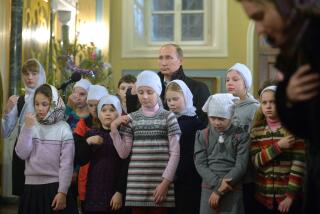The Sex That Perestroika Has Forgotten : Women: Falsely heralded as the home of the liberated female, the Soviet Union is moving backward in politics as well as in personal life.
- Share via
MOSCOW — The camera scans the Congress of People’s Deputies, where a brand new political system is being created. It is a sea of male faces. On the brink of the next decade and a new millennium, the world’s freshest democracy turns out to be the same old men’s club.
Where are the women of the Soviet Union, if not here in the corridors of power? They are 53% of the population and a mere 5% of this new elected body. “The women are in the kitchen,” says Stas Borevich, a 23-year-old linguistics student from the Urals. Like most Muscovites, he hasn’t much noticed the absence of women in the new government.
Under the old regime, there was a 30% quota for women in the Communist Party, but none sat in the ruling Politburo; fewer than a dozen served on the 307-member Central Committee. The old propaganda cranked out to the West, depicting women practicing medicine and driving steamrollers, contended that the Soviet Union was the place where women were “liberated” first. But as any visitor here can see, and as Francine du Plessix Gray has documented in her book “Soviet Women: Walking the Tightrope,” the alleged progress was a myth.
Soviet women have had an equal opportunity to work at many traditionally male jobs, particularly since so many Soviet men died during World War II. Women were needed to fill out the factory production lines and some of the professions, including medicine. But doctors aren’t treated with the same status and income here as they are in the United States; in medicine and elsewhere, Soviet women have remained stuck in the lowest-paying jobs in a culture that doesn’t seem to value their contributions equally with men’s.
“Have you ever seen a woman in our official (Soviet) delegations?” asks Vera Soboleva, head of the international department of the Soviet Women’s Committee, an officially sanctioned organization with 3 million members. She observes that this dearth of women hasn’t changed under perestroika; a typical recent example, she says, was the official all-male delegation of 26 Soviets visiting the United States to study marketing.
Soviet women didn’t rise to positions of real economic or political power before glasnost and perestroika --and there’s no evidence that they are rising now. In fact, there’s every reason to believe that Soviet women are losing ground in the changing system here. It’s uncertain what will replace the few supports they had under the old system: state-sponsored day-care for children, health care, assured jobs. These were hopelessly inadequate under the old Soviet regime, but they were better than the looming void.
Many Soviets, men and women alike, are skeptical that the new political system will actually produce anything better, so it’s not surprising that those who face the greatest political obstacles aren’t trying to participate. “Women have never been serious policy-makers here,” says Natalia Gevvorkyan, a 33-year-old reporter for Moscow News. “We still do not have any formal feminist movement. Most of the women here do not see how to change their lives for the better.”
All this makes the United States look like a feminist haven, even though American feminists are quite rightly discouraged these days. The American feminist faces the loss of abortion rights under the Supreme Court, the backlash against affirmative-action laws and the political indifference to President Bush’s veto of the Family and Medical Leave Act. That legislation would have eased the burden on working women by guaranteeing men and women unpaid time off to contend with births, adoptions or family medical emergencies.
Yet the American women’s movement, however disheartened it may seem today, has produced significant and lasting cultural changes that don’t exist in the Soviet Union. An estimated 92% of adult Soviet women work for wages, taking care of their children and, often, their aging parents, in a culture that discourages men from helping at home.
Soviet women also wait in line for an estimated family average of 2 1/2 hours each day to buy food and other staples. “We don’t have things that are absolutely necessary for women--Tampax, medicine,” Ms. Gevvorkyan observes. Finding birth-control devices or pills is very difficult. In 1987, there were 115 abortions for every 100 live births in the Soviet Union; often both abortions and births were without anesthesia, according to feminist publisher Tatyana Mamonova, who recently was a visiting scholar at the City University of New York.
Without a culture that supports women’s basic needs, it’s not surprising that the few Soviet women who have gotten elected to office have worked to ingratiate themselves with the dominant male power structure rather than to challenge its priorities. They “sometimes are very shy to present women’s issues,” Soboleva observes.
Indeed, Svetlanta Goriatchev, a deputy to Russian Republic President Boris N. Yeltsin and therefore one of the highest-ranking women in the new political order, doesn’t follow the feminist line. As Soboleva and others fight for access to birth control, Goriatchev is actively pushing for Russian mothers to have more babies. While feminists are worrying about who will pay for day-care centers and how women will survive in the less protective market economy, Goriatchev is advocating the popular fantasy that women should return to the home.
“The child-care system doesn’t make the life of the mother easier. The best possibility would be to remain home in the first year,” she says, disregarding the fact that most Soviet women aren’t economically able to do so.
Even Gevvorkyan, who aspires to be a foreign correspondent and assumes her editors will never select a woman for such a post, declares: “I am not a feminist.”
If anything, young women here are heading in the opposite direction--holding up the 1950s suburban American ideal. They dream of staying home, dependent on their new capitalistic, presumably affluent husbands. “There is a huge movement among Soviet women to show how fragile they are. It’s partly because things have been so tough here,” explains Irene Stevenson, an American woman who is working as a translator at TASS, the official Soviet news agency.
At a contest in the Baltic Sea region to select “the best wife” in the area, Stevenson reports, contestants were asked, among other things, “If a volcano was exploding, what hairstyle would you wear?” While that might be an extreme example, there is much evidence of a feminine--rather than a feminist--movement here. “Traveling in the Soviet Union, one is immediately struck by the passionate interest evidenced by the generation under 45 in traditional domestic rituals--cooking, sewing, embroidery--which their grandmothers never had the time (or the permission) to indulge in,” writes Du Plessix Gray.
Understandably, Soviet women are exhausted--even more than America’s superwomen, who at least have supermarkets and high-tech gadgets to help them juggle their double lives. “Many see how their mothers lived and don’t want to follow their example,” concludes Vera Soboleva of the Soviet Women’s Committee. But the dilemma is that in order to improve their lives significantly, they need to take on still another time-consuming and thankless job--that of fighting for the kind of political leverage needed to secure greater economic, cultural and political standing for women in Soviet society.
“Some women think only about their everyday needs,” Soboleva laments. “They don’t understand that if we don’t change thinking on a general global level, their everyday needs will never be changed.”
More to Read
Sign up for Essential California
The most important California stories and recommendations in your inbox every morning.
You may occasionally receive promotional content from the Los Angeles Times.













